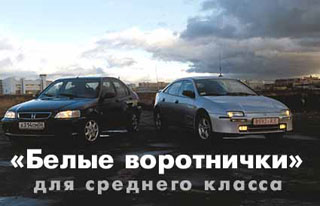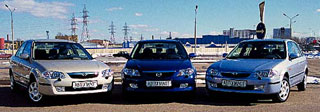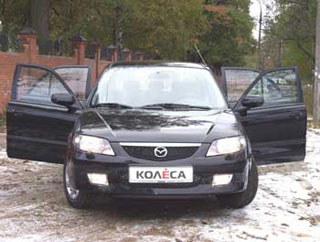Test drive Mazda 323 F 1994 - 1997 hatchback
Incorrect comparison
Compare Mazda 323 and Kia Rio? Yes, between them, the abyss of several thousand cu! Nevertheless, let's try. Yes, the significant differences between these cars are obvious, but something is related to them. This is something - an unusual five -door body: either a hatchback or a station wagon. In fact, there are very few such hybrids in the market, and these are also close in overall dimensions. We take it!Ba, but they also have engines, that one, that the second - both of 98 hp. They give out and do not diverge much in the working volume! And the fact that one car is significantly more expensive than the second is not a problem: it is all the more interesting to compare.
It’s like when you stand on the market and suffer from the problem of choice: take a Korean radio or Japanese (well, not Japanese assembly, but some kind of t ...). There seems to be no difference - both of the other have an equal set of functions, the parameters are the same, and they seem to sound the same ... But then why is the second worth so much? And immediately several options arise in the mind:
a) as you pay and get it - it is better to overpay a little, so as not to regret it later;
b) the Japanese have already spun, and they earn on the name, and the Koreans have not yet had time, and therefore cheaper;
c) there is a difference, but it only will catch it; In extreme cases, you will have to come to terms with one or another drawback, but for that kind of money - easily!
And in the end, everyone decides for himself what he needs. It is somewhat different with cars, but the principle is maintained: a cheap model can be good (with a number of reservations), but not the best. Unless in terms of price/proposed qualities.
The only car in the family? The design is visible!
Perhaps it was this role that both Mazda and Kia for their models predetermined. The basis for such an assumption is again an unusual body. In Western Europe, the most popular type is hatchback. But such a car, although it differs in practicality, but it can not always offer a large amount of luggage compartment. If this is the second car in the family - no problem. And if the only one? There is a versatility, but not a station wagon ...
No, station wagon, UPV, a minibus do not always correspond to the wishes of some customers. They do not need a volumetric car - a fairly ordinary golf -class hatchback, but only with a transformable salon and roomy trunk. What follows from this? But what: a modest charm for every day. In other words, the car should be comfortable, attractive and with a balanced design.
The appearance of Mazda is really balanced. So much so that even somewhat boring. It is curious that the predecessor with the same index (323 F) had a clearly expressed sports character. What was appreciated by active drivers, but did not inspire the family people: a low body with small doors without window frames prepared in advance to bend when boarding in a car, and also hinted that only the driver and the front passenger would be spacious, and it is desirable that baggage would be luggage It was smaller.
The new generation got rid of aggressiveness, added in comfort and capacity - this is visible at first glance. The main feature is the proportions of the body. If the roof was a little shorter, and the angle of inclination of the back door is larger, a regular hatchback would have turned out. But this elongation not only adds the interior of the salon, but also makes the appearance of the 323rd memorable. In general, Mazda is perceived as a little not expensive to the normal overall length of the station wagon, which in itself is entertaining.
However, what to talk about design - the model has been produced since 1998, so that her appearance managed to become salted. However, last year, Mazda 323 was modernized and slightly changed its appearance. It’s a matter of taste, but I like a prerestyling version with wide headlights more - the car looked more harmonious. This is the 626th narrow headlights go, and here they dried the front of the EFCA. But tastes and color ...
Ah, how it suits Kia Rio! There is certainly who will like it. It is assumed that a magnificent body with a brace of optics should make a car visually more expensive. Again, subjective opinion: the design is unusual, but it does not seem expensive, probably because not all elements are in harmony with each other.
Look: what kind of monument is behind the back door - for some reason the line goes up. Probably in order not to repeat others. But after all, the area of \u200b\u200bglazing is reduced, as a result of visually the feed is weighted, and the circular review becomes worse. However, if this was not - the car would become an ordinary station wagon. And so the hatchback with intrigue ... the inner space
Well, that's enough to admire - it's time in the salon. I sit in a Japanese car, and ... yes, you can see immediately: they developed it in the last century. No, nothing bad, just the salon is traditional for models, so to speak, the previous generation. Now what is in fashion? That's right, the thick racks of the roof, leaving along with the lower part of the windshield half a meter forward, a rather high landing, a huge number of pockets, secretaries, cup holders, etc. And the panel in the style of techno.
Inside the 323rd is not so. Not certainly in that way. There is no huge liquid crystal display in the central console, and the devices are the most ordinary. Which, however, does not prevent the driver from conveniently getting driving and without problems getting the information he needs, since the devices are well read.
And the salon is transformed! So, the chair of the front passenger can be turned into a table - just throw the back forward (where is the front passenger to put the front in this case?). The rear seats can also be laid out, moreover, in a 2: 3 proportion, so a compromise is possible on the issue of choosing between passengers and luggage. By the way, with the rear row you can do other interesting things: move the pillow, change the back of the back and so on. Of course, now you will not surprise anyone. But remember when this car appeared. We can say that far -sighted people work in the company. After all, right, yes?
Okay, you can not answer. In the meantime, I will sit inside Rio. Hmm, the same combination of plastic in the design of the dashboard is black with gray. But the very quality of the material is worse, and it looks somehow easier. However, it looks quite modern and ... boring. Pleasantly surprised the driver's seat with German developed lateral support. And what is it? Oh, the seat pillow is adjusted in height separately: both in front and behind! I mean, its front part and back. As a result, he sat down as a glove, but when he sat behind (without changing the position of the chair), my feet were crowded.
By the way, the Rio wheelbase is shorter than 20 (!) Cm, while the length is approximately at the same level. But the Korean car and the rear overhang is longer, therefore, there will be more trunk. So it is: according to passport data, KIA contains from 450 liters, and Mazda - from 345 liters. But at the same time, the Rio salon transformation of the 323rd salon cannot boast. Yes, and in the Japanese trunk ... more comfortable - personally checked!
We will go, we will rush ...
Although no, it’s better to just go. The fact is that both cars do not claim the title of urban car - apparently, that rational grain was too well ...
As mentioned above, cars with equal capabilities got to the test. After modernization, instead of an old one and a half liter engine with a capacity of 88 hp. Mazda had a 1.6-liter in 98 hp. Exactly the same is the Rio engine, but with a working volume of 1.5 liters. As expected to sixteen -clapans, both engines at low speeds, as they say, are not pulled. That is, they disperse the car, but not all ninety -eight. In the sense of strength.
The situation improves when the tachometer arrow passes 3.000 rpm - the acceleration intensity immediately increases. Hence the confirmation of the old truth about multi -valve engines: you like to drive - hold the momentum! Moreover, it is worth noting that if Mazda simply accelerates, then the Kia motor also makes a decent noise in all its sixteen valves ...
According to the passport, both cars up to one hundred kilometers per hour are accelerated equally - for 11.6 s. In practice, the Korean car is slightly slower: the hitch occurs due to fuzzy inclusion of gears. But to drive quickly desires does not arise either on Rio or on the 323rd. Especially on our roads. After all, pendants of both machines were created under normal operating conditions, and therefore they react at our potholes, let’s say, inadequately.
Especially nervous Rio. His suspension is tough, short -term. And therefore, which feels almost BMW on a normal coating, on a broken road, Rio begins to shake and moan. It’s better not to torment the poor man, and this site is a little quieter. Mazda does not react so painfully, but its slightly harsh suspension loves to repeat the joints and small defects of the road surface, while larger troubles are overcome without any problems.
Well, in general, this picture looms. Mazda does not somehow claim the role of an active car, making everything with its being that its purpose is a reliable movement of people and their baggage from point A to point B. But if an emergency arises (which the car itself is unlikely to provoke), That good handling should help to get out.
But Kia sets and provokes to go quickly. And how you go - you understand that this is not his element. And the engine seems to be pulling, and the suspension on a good road is moving, and the steering wheel is perhaps sharp, but the engine is noisy at high speeds so that you involuntarily want to switch to the highest gear, and the box is cotton ...
Summing up
Mazda 323 F is a Japanese view of a budget car. Without any special delights, but okay tailored and confident. Even after four years since the start of production, he still holds well as well as well, although there are no newfangled bells and whistles in the arsenal. A relatively small amount of luggage compartment is compensated by the good transformable of the passenger compartment.
Kia Rio plays catch -up, but so far loses. Now it is clear why the difference in price is so great: in almost all respects, the Korean car does not reach Japanese, although it appeared two years later. There were no major shortcomings, but there are enough small flaws. And in the end, the general level is average or even lower than that. But the price too!
The Japanese car is much more expensive. But during operation, no questions arise. And you begin to make a claim to Kia almost from the first kilometer. You can put up with disadvantages if you remember how much you saved on the purchase.
If there is enough money only for Kia, why not take it? If there is on the 323rd, and even with a margin, there are also no questions. And if so: either now Kia with complete minced meat, or an empty Mazda in a year? But such a situation is unlikely to ever come: these cars are different, and therefore, buyers too.
Text: Sergey Pustoznov
A source: Autogazet / N 20 (366) dated 05.06.02



